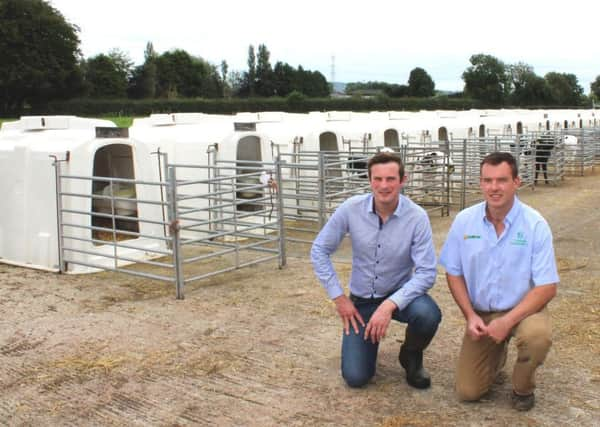Hutches provide calves with the perfect start


“We are calving cows for 11 out of the 12 months of the year,” he said.
“Traditionally, we would have reared calves in pens, that were grouped together. But what we found was that once a single calf took ill, the problem spread to all the other animals alongside it. Another problem was the fact that we could never clean the pens out to my satisfaction between each calf.
Advertisement
Hide AdAdvertisement
Hide Ad“Two years ago, we decided to switch tack and bought 20 calf hutches. Kept outside on concrete, but straw bedded, we found that they provided individual calves with their own living space. And this approach has tremendous advantages.
“In the first instance, each calf has access to plenty of fresh air. This is an inherently healthy approach. But, in addition, should a calf take ill, it meant the animal was automatically isolated from the rest of its comrades.”
Sam maintains the calves in the hutches for the first two to three weeks and then transfers them on to an automated calf feeder.
“By that stage the animals are strong enough to withstand the pressure of being grouped together. Because the animals are only in the hutches for a few short weeks, we have found that it is feasible to couple them up within each unit.
Advertisement
Hide AdAdvertisement
Hide Ad“Once the calves have been taken out, each hutch can be easily lifted away and power washed with warm water. This approach ensures that each hutch is thoroughly cleaned out.
“While all this is happening the old bedding can be quickly removed and the concrete surface disinfected, prior to the hutch being put back in place. It is also policy on the farm to relocate the hutches around the yard.
“During the winter months, we fit the newborns with calf jackets, so as to prevent them from catching a chill.”
Sam invested in the Agri Plastics’ range of calf hutches, which were purchased from Teemore Engineering. Manufactured in Canada, they are renowned internationally as the toughest of their kind on the market today.
Advertisement
Hide AdAdvertisement
Hide Ad“Both group and single calf options are available,” confirmed Teemore’s Adrian Bates, a recent visitor to the Hill farm.
“What makes these hutches different is the quality of the plastic used in the manufacturing process. As a consequence, they have a 50% better impact strength, a longer life and being totally opaque, ensure high Ultra Violet protection at all times. In fact, the hutches come with a ten-year guarantee.”
In essence, the Agri-Plastics hutches guarantee the perfect environment in which to rear young calves.
Adrian Bates again: “Each group hutch can cater for up to six calves. Innovative features include a unique roof-based variable ventilation system, plus operator access front and rear, to facilitate easy cleaning and feeding. The entrance at the rear is facilitated by a three-in-one door
Advertisement
Hide AdAdvertisement
Hide Ad“As a result, the group hutch can be easily accessed in order to facilitate the inspection of individual calves,” Adrian continued.
“A front mounted penning system is included with both the single and group hutch options, thereby providing calves with an additional exercise area at the front of their accommodation.”
As milk producers know only too well, giving calves the best possible start in life is fundamentally important to the long term future of their businesses.
“The Agri-Plastics hutches give farmers total control over their calf rearing practises,” Adrian concluded.
Advertisement
Hide AdAdvertisement
Hide Ad“Teemore will also supply all the feeding bottles and buckets required to ensure that the needs of each individual calf are met in full.”
For further information, contact Teemore Engineering on (028) 6774 8377